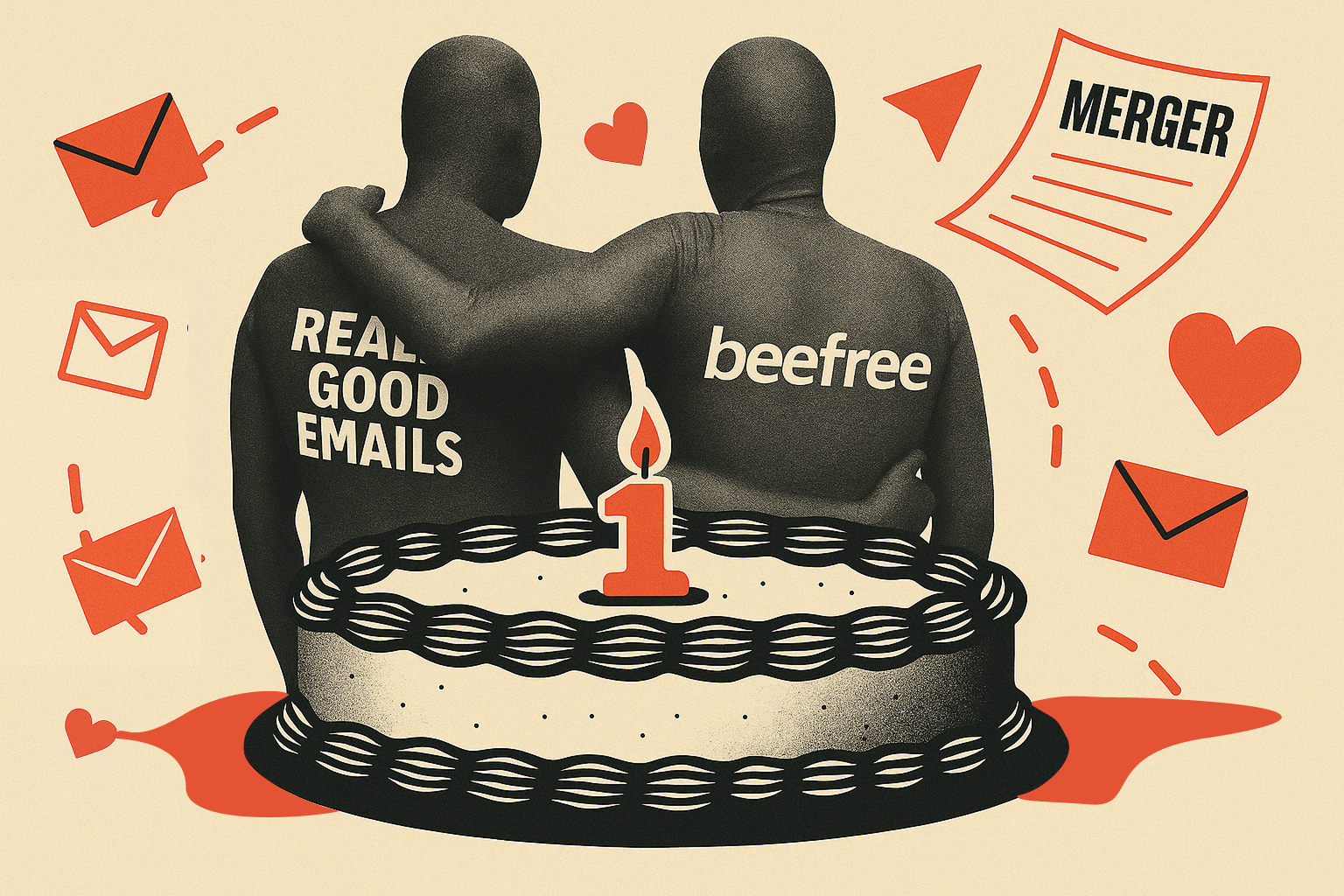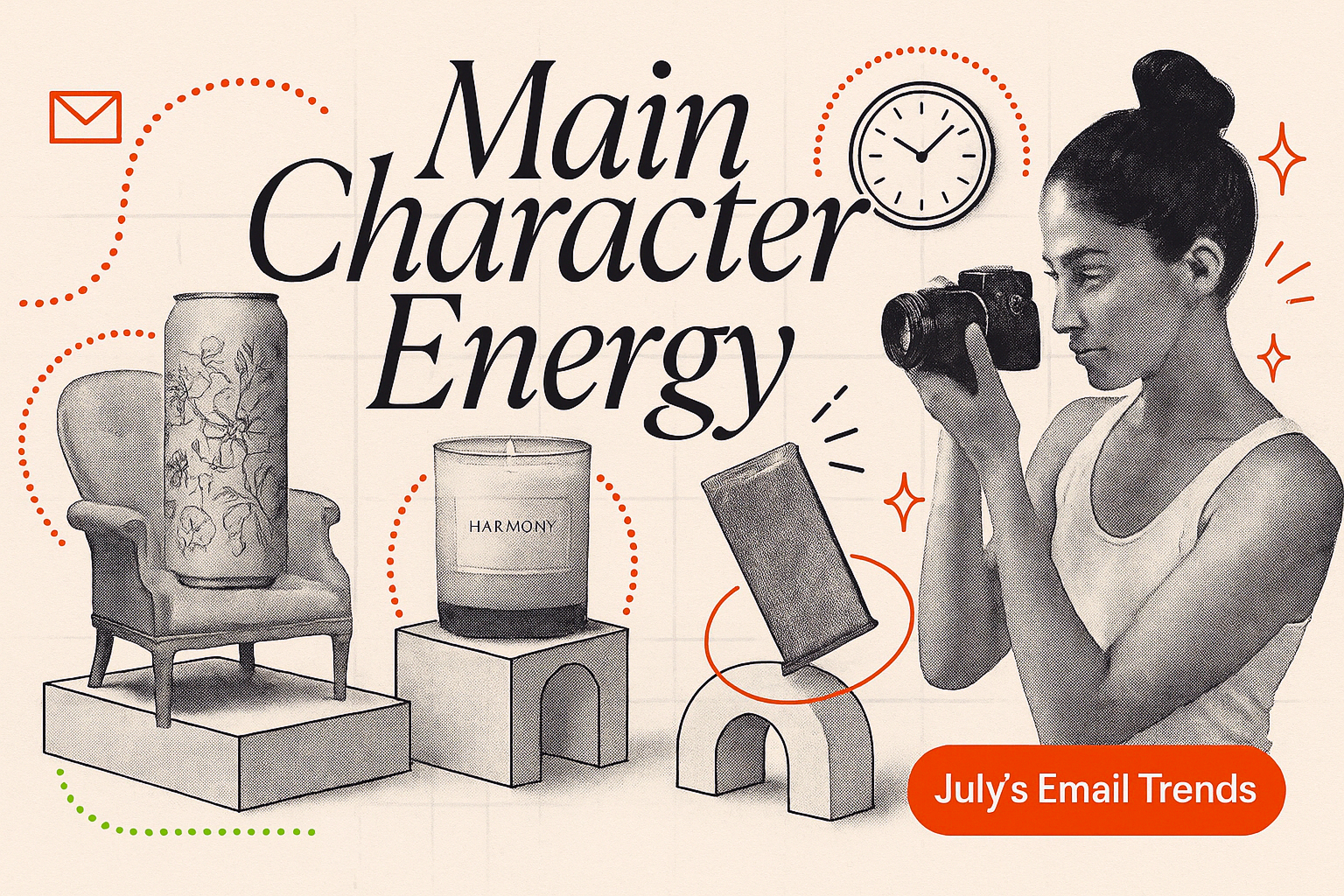They say summer is when things slow down. But this July? The inbox came to impress. Unlike the formulaic lineups of “20% off everything under the sun” and “Your beach essentials await,” July’s best emails put down the megaphone and picked up a director’s lens. They weren’t just trying to convert; they were trying to capture. And for once, the vibe wasn’t “hurry up and buy.” It was “pull up a chair and sit with us for a while."
This month felt different—more confident. More editorial. It was like brands collectively decided to take a break from begging for attention and instead built little worlds that deserved it. These emails weren’t shouting over each other in the inbox. They were giving strong silent film energy. Cinematic lighting. Prop styling. A plot twist in the form of a probiotic supplement with a pastel label.
We saw fewer cloned templates and more statements. Emails leaned into storyboards, textures, and tones that demanded a second look. Not because they had a discount code, but because they had taste. The kind of taste that says, “We didn’t just make a product; we made a protagonist.”
As Seth Godin famously put it, "Marketing is no longer about the stuff that you make but about the stories you tell." And this month, those stories weren’t being screamed. They were stylishly whispered, with a wink, some art direction, and a citrus-infused candle for ambiance.
So if you felt like July’s emails had a certain... main character energy? You weren’t imagining it. They did. And we’re here to break down exactly how they pulled it off.
📦 How packaging, personality, and play took center stage in July’s emails
Email makers knew their angles. They had good lighting. What made emails this month different wasn’t just prettier photography, but rather smarter strategy. We noticed meta layers: lighting wasn’t just functional, it was emotive (research shows lighting heavily shapes purchase intent). By placing a single object centrally, marketers enhance visual fluency, making the product feel more familiar and appealing within milliseconds. And with those elements combined, the products gave that seductive look, saying something cryptic like “I’m not like the others in those emails.”
So, in other words, instead of leading with discounts, most emails this month handed the spotlight to their product. But these weren't typical emails. They were full-blown magazine-styling looks. Moodboards with ambitions. Emails that looked like they were one beret away from moving to Paris and launching a fragrance line.
In July, packaging didn’t just show up—it showed off. Brands like Unwell stacked its liquid hydration on top of a tower of kids' floaties. Flamingo Estates nestled its candle on a tomato (yes, a tomato) like it was a moody still life curated by a food critic with a soft spot for soy wax. Maeve held up its chocolate bar like it just received a Tony Award.
These weren’t “product shots.” They were personality auditions.

We're living in a golden age of object-based storytelling. Our brains crave context and character, even in packaging. If that bottle looks like it belongs in a Wes Anderson film, suddenly your daily vitamin routine feels more cinematic than sad.
Design psychology hit: This taps into personification bias. We love to assign human traits to inanimate things. If your bottle looks like it’s feeling itself, we’re weirdly more inclined to believe it’ll help us glow up, too. Want your product to be remembered? Treat it like a guest on Hot Ones or Chicken Shop Girl. Give it a chair, a light, and a setting where it can emotionally unravel.
🧱 Text as texture
Then there were the typographic peacocks that strutted into inboxes this month. The Ordinary didn’t just use type; it layered it—so large, it practically leaned out of the screen to ask if you exfoliated today. Methodical Coffee juxtaposed the word "Tea" across the screen so that you couldn't confuse it with something else. And Bubble used two words to anchor their products' lure in your brain. These were meant to be felt as much as they were meant to be read.
This isn’t copywriting. It’s vibe setting.

The thinking is that we now live in the Attention Economy™. People don’t so much “read” emails as they “emotionally scan” them while pretending to be in a Zoom meeting. Oversized type triggers emotional priming, which means it gives your lizard brain a tone check before your frontal cortex has even shown up to work.
Text as wallpaper isn’t just cool—it’s efficient. It lets brands scream “FRESH” or “GLOW” or “LAST CHANCE” without using another millisecond of mental energy.
Use it sparingly. Use it like seasoning. But when done well, it turns a blah layout into a full-blown aesthetic declaration.
⏰ This email is about your routine, not our revenue. (Okay, maybe both.)
Brands are starting to understand that no one wants to be sold a product. We want to be invited into a story—preferably one where we wake up glowing, energized, and with a perfectly timed espresso in hand.
Zoom and Miro did this beautifully in July, showcasing how their tools fit into your daily workflow. No fluff. No vague promises. Just a tight narrative that goes: “Here’s your morning. Here’s how we slide in around 9:17 AM.”
Eden and Apple followed suit with health flows that mirror a routine: apply, glow, repeat.
This works because of procedural memory—your brain gets attached to tasks it can visualize doing. Show me how your thing fits between brushing my teeth and checking Slack, and suddenly I’m halfway to buying a subscription.
Design tip: Storyboard it. Timeline it. Even “Step 1 / Step 2” visuals work. Make your email feel less like a billboard and more like an IKEA instruction manual that is easy to understand and doesn’t make you angry that you started the project but now have multiple pieces that are left over somehow.
♾️ Arches: The Comeback of Gentle Geometry
High-contrast grids? They took a summer sabbatical. In their place, curves quietly reclaimed the inbox in July, with brands like Ghia, Medly, and Delta leaning into arches like they’d just rediscovered geometry class—only this time with better taste. Ghia used curved image windows to funnel attention like a design sommelier decanting visual focus. Medley softened the scroll with rounded hero cards that felt more spa day than spreadsheet. And Delta added breathing room with arch stamps and semicircles that guided the eye without a single "click here."

This wasn’t just a design choice, but rather a nervous system strategy. Arches, according to research in visual cognition, evoke ease, flow, and harmony. Their organic shape contrasts with the rigidity of boxes and lines, signaling safety and subtle sophistication. Think boutique windows, cathedral ceilings, or the entryway of your favorite cafe.
In a world of inbox hustle, arches let your emails exhale. They create rhythm. They build trust. And if done right, they suggest, ever so softly, that your message is worth relaxing into.
💚 The New Highlight Color of Choice? A Hit of Green
If the rest of the email is calmly speaking in soft neutrals and moody photography, the CTA is now allowed to hum a little louder. This month, brands like Brez (#C0F381), Wooden Spoon (#CAF5AE), Verb (#E5FF77), and Wuffes (#C5FA54) used bright greens not as design noise, but as elegant punctuation. Against a minimalist backdrop, that electric hue says “this part matters.”

According to research on the Von Restorff effect, distinct visual elements are more likely to be remembered—especially when used sparingly. When placed on a soft stage of editorial restraint, these citrus greens don’t scream. They spotlight. They become part of the scene, not a break from it. And in the story-led structure of July’s emails, they’re less like a carnival barker and more like a director’s underline.
So as we head into August, the big question is: how are brands going to keep this momentum going? After the visual feasts we saw in July, the inbox is going to be on the edge of its seat, ready for brands to really flex their creative muscles.
August has some big shoes to fill, but I have a feeling the inbox is about to get even elevated. Maybe we'll see brands adopt new email design templates. Or dive deeper into those little moments that make up our daily routines. Heck, they might even just straight-up make us laugh.
Whatever they do, I'm betting it'll be way more than just another discount code. A higher standard is here and it's time for brands to get creative, get personal, and give us emails we actually want in our inbox. No more phoning it in. The inbox is a stage, and July just proved that people are ready to be entertained.


